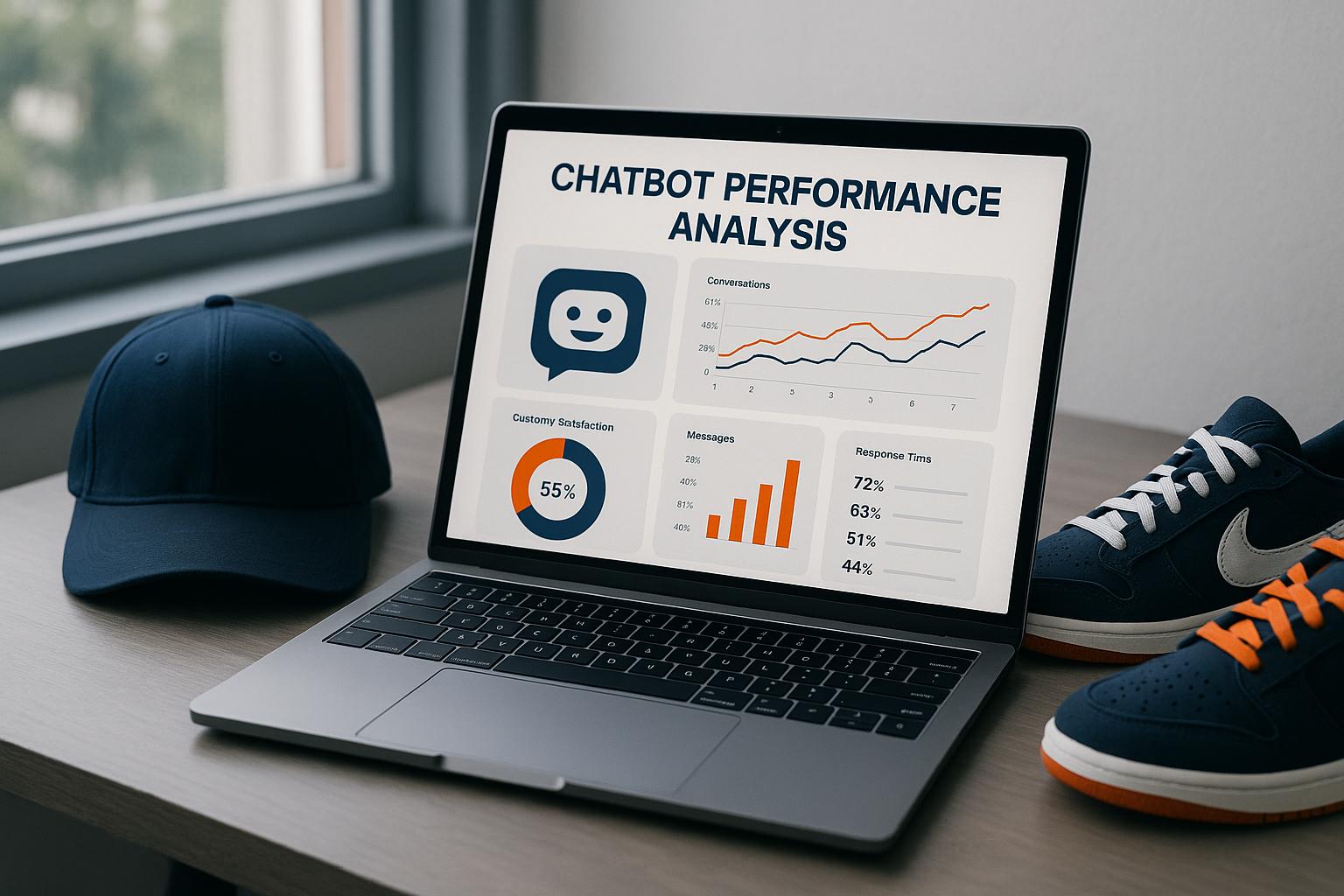AI workflow automation streamlines repetitive tasks like CRM updates, follow-ups, and customer segmentation, saving time and boosting productivity for marketing and sales teams. Unlike rigid traditional automation, AI systems analyze data in real-time to make smarter decisions and improve processes without constant manual adjustments.
Key takeaways:
- Time savings: Sales teams can save over 2 hours daily by automating tasks like lead scoring and scheduling.
- Improved results: Companies using AI have reported a 10–20% ROI increase and faster lead response times.
- Integration-ready: AI tools work with platforms like Salesforce, HubSpot, and LinkedIn Ads, making adoption seamless for U.S. teams.
- Data quality matters: Clean, structured data ensures automation works effectively.
- Team alignment: Involve marketing, sales, IT, and operations to ensure smooth implementation and success.
To get started, evaluate your current tools and data, identify repetitive tasks to automate, and choose AI platforms that fit your needs. Begin with small pilot projects, track results, and expand automation across departments for scalable success.
Preparing for AI Workflow Automation
Review Your Current Tech Stack
Start by taking stock of your marketing and sales tools. Create a detailed list of everything your teams use daily – your CRM system, email marketing software, analytics dashboards, project management tools, and platforms for social media or advertising. For each tool, note its primary function, how often it’s used, and its ability to integrate with other systems.
Pay close attention to integration compatibility – this is key for AI automation. AI platforms thrive on tools with robust APIs and open data standards. For example, ReadyLogic‘s CRM integration showcases how seamless connectivity can automate pipeline updates and contact logging, saving teams over 8 hours per week per representative.
Evaluate whether your current tools can handle the demands of AI automation, including increased data flow and processing needs. Older systems with limited integration options might need upgrades or replacements to fully unlock AI’s potential. By identifying gaps and inefficiencies now, you’ll be better prepared to decide which platforms to update, replace, or complement with AI-powered solutions. Once your tech inventory is complete, the next step is ensuring your data is ready to support automation.
Check Data Quality and Readiness
Before diving into AI automation, ensure your data is accurate and well-structured. Clean, consistent data is the backbone of effective AI workflows; even minor errors can disrupt automation processes. Start by reviewing data from all your sources – CRM records, email lists, website analytics, and customer databases.
Watch for common issues like duplicate entries, outdated contact details, missing fields, or inconsistent formatting. Also, check if your systems use the same standards for organizing customers, leads, and interactions. AI systems rely on reliable and uniform data to make decisions and trigger actions effectively.
Adopt regular data hygiene practices to maintain quality. Automate deduplication processes, set validation rules for new entries, and standardize formats across platforms. For instance, ensure phone numbers, addresses, and company names follow consistent formatting across all systems.
Focus on the data sources that directly impact your automation goals. Prioritize CRM records, website engagement metrics, email interaction data, and behavioral signals from marketing channels. These data streams are essential for lead qualification, customer segmentation, and campaign personalization – the core of most AI-driven workflows.
To keep your data in top shape, schedule monthly audits to catch and fix issues before they affect your AI systems. While AI platforms can handle tasks like audience segmentation and real-time record updates, their success depends on the accuracy and structure of the data they process.
Find Your Team Members
Successful AI workflow automation requires clearly defined roles across your marketing, sales, and operations teams. Start by appointing a project manager to oversee the implementation process. This person should be able to bridge technical requirements with business goals, ensuring alignment across departments.
Your marketing and sales leads are crucial for identifying workflow priorities. They know firsthand the repetitive tasks and bottlenecks that AI can address. Their input will help determine which processes to automate first and guide testing phases.
Bring in data analysts or tech-savvy team members to monitor data quality and system performance. They’ll help enforce the data hygiene practices critical for AI success and troubleshoot any issues that arise. If your team lacks technical expertise, consider hiring specialists to fill the gaps.
You’ll also need IT specialists to handle technical integrations, ensuring AI platforms connect seamlessly with your existing systems. They’ll manage security protocols and compliance requirements tied to automated data processing.
Don’t underestimate the value of internal champions or AI advocates – team members who are enthusiastic about automation and can inspire others to embrace the change. These individuals can provide peer training and address concerns about adopting new technology.
Operations staff play a vital role in ensuring that automated workflows align with company policies and industry regulations. They also monitor performance and help scale successful automations across teams.
Finally, plan for change management from the outset. Start with simple automations and gradually expand to more complex workflows. Clearly communicate the benefits of AI, emphasizing how it saves time and enhances job satisfaction rather than replacing human roles. Regular training sessions should focus on practical applications and how AI can simplify daily tasks, making the transition smoother for everyone involved.
Build Your First AI Automation Workflow in 14 Minutes (No code)
Step-by-Step Implementation of AI Workflow Automation
Using AI to automate workflows can simplify essential marketing and sales tasks, saving time and reducing errors. Here’s how to get started.
Find High-Impact Automation Opportunities
Begin by identifying tasks that can benefit most from automation. Apply the 80/20 rule to focus on repetitive, time-consuming actions like lead scoring, email follow-ups, CRM updates, and audience segmentation. These are areas where AI can significantly reduce manual effort and errors.
"The Pareto Principle is in full effect in Digital Marketing. If your team isn’t capitalizing on the 20% of work that drives 80% of your marketing results, we need to talk." – Jeff Lizik, Founder, RedShift Digital Marketing Agency
Pinpoint processes prone to human error, such as data entry mistakes or missed follow-ups. AI thrives on maintaining accuracy and consistency, making it ideal for these tasks. Look at customer journey touchpoints too – automation can enhance experiences through intent-based triggers, behavioral responses, and real-time personalization. For example, a B2B company using ReadyLogic’s AI-powered lead scoring saw a 30% reduction in lead response time and a 40% increase in conversions by automating their qualification process.
Once you’ve identified these opportunities, move on to selecting the right AI tool for your needs.
Pick the Right AI Tools
Choosing the right AI platform is crucial. Look for tools that integrate seamlessly with your CRM, offer scalability, and meet U.S. compliance standards. Evaluate features like ease of use, API compatibility, real-time processing, and analytics dashboards.
Here’s a quick comparison of popular tools:
| Tool | Pros | Cons |
|---|---|---|
| ReadyLogic | Excellent CRM integration, end-to-end automation, U.S. compliance, user-friendly | May require onboarding for advanced features |
| Outreach | Multi-channel automation, AI-driven insights, robust analytics | Higher cost, learning curve for new users |
| HubSpot | All-in-one platform, easy setup, strong support | Limited customization in lower tiers |
| Salesforce | Highly customizable, extensive integrations | Complex setup, higher price point |
Consider the platform’s learning curve and how quickly your team can adapt. Tools with intuitive interfaces and detailed training materials make adoption smoother. Vendors offering dedicated support during setup and optimization phases can make a big difference.
Pricing varies widely. Outreach starts at around $100 per user per month, while other platforms range from $50 to $300 monthly, depending on features and scale. ReadyLogic typically provides custom quotes based on team size and specific needs.
After selecting a tool, the next step is building and testing your first automation workflow.
Build and Test Your First Workflows
Start small by automating one high-impact task, such as follow-up emails or lead assignments. Map out triggers, actions, and key performance indicators (KPIs) to measure success. Testing in a sandbox environment helps you identify and fix issues before going live.
Define your success metrics upfront. Whether you’re tracking response rates, conversion improvements, or time saved, establish baseline data for comparison. For instance, a mid-sized sales team saved 8 hours per week per rep by automating pipeline updates and contact logging.
Run initial tests on a small dataset and collect feedback from your team. Their input can highlight practical adjustments needed for timing, messaging, or integration with existing workflows. Sales reps and marketing specialists often provide insights that technical testing alone might miss.
Monitor the workflow closely after launch. Track the predefined metrics and watch for any unintended effects on customer experience or team productivity. Be ready to tweak the workflow based on real-world performance.
Document your findings during testing. This will be invaluable for scaling future workflows or troubleshooting any issues down the line. Once your first workflow is running smoothly, use the lessons learned to refine and expand your automation efforts. Even small adjustments can lead to noticeable gains in efficiency and results. This iterative process not only boosts performance but also builds confidence within your team as you take on more complex automation projects.
sbb-itb-d6d4d8b
Improving and Scaling AI Workflows
Continuously refining and scaling your AI workflows can turn automation into a powerful tool that delivers measurable results for your business.
Use Analytics to Improve Workflows
Data is the backbone of workflow optimization. Start by monitoring key metrics like conversion rates, lead response times, cost savings, pipeline velocity, and time saved. Set aside time to review dashboards regularly. This will help you pinpoint issues like stalled deals, repetitive tasks that automation hasn’t resolved, or automated triggers that aren’t working as expected.
For example, compare pre- and post-automation costs to understand the financial impact. If your team used to spend 10 hours a week on lead qualification and automation has reduced that to 3 hours, you’re not only saving time but also cutting costs. Additionally, track revenue growth driven by improved conversion rates to measure your return on investment.
Don’t forget to monitor engagement metrics like email open rates, click-through rates, and conversions. If you notice a drop in response rates for automated follow-ups, it’s time to tweak your approach – whether that means adjusting timing, refining your messaging, or rethinking your targeting based on behavioral data.
Analyzing customer behavior can also reveal which actions lead to the best outcomes. Use these insights to fine-tune your workflow triggers, ensuring your automation aligns with what’s actually working.
All of this sets the stage for scaling automation to other areas of your business.
Expand AI Across Teams
Once you’ve nailed down the analytics, you’re ready to extend AI workflows across teams. This ensures a unified approach to customer engagement, especially when marketing and sales are aligned on shared goals. Start by identifying processes that connect both departments, like lead handoffs, customer journey tracking, or campaign attribution.
A key step here is cross-channel orchestration. When email, ads, CRM, chat, and other tools work together, you can create seamless customer experiences. For instance, high-intent signals can trigger real-time sales alerts or align ad targeting with email follow-ups, ensuring consistent messaging.
Data integration is critical for scaling. Unified customer profiles allow both marketing and sales to access the same information – like behavioral signals, engagement history, and interaction scores – avoiding duplicate efforts or conflicting actions.
Another helpful strategy is content atomization. By breaking content into modular, reusable pieces, you can adapt it for different channels and stages of the customer journey, making your automation efforts more scalable.
Real-time analytics dashboards are invaluable for cross-team collaboration. Marketing can track which campaigns bring in the most qualified leads, while sales can monitor how automation impacts deal progression.
Don’t overlook the human factor when scaling automation. Training and change management are essential. Assign team champions to guide adoption, provide support, and collect feedback. Regular cross-team meetings can help resolve integration challenges quickly and keep everyone aligned.
Maintain Long-Term Success
To ensure your workflows remain effective over time, schedule quarterly audits to update automation rules and remove outdated processes. If you’re handling customer data in the U.S., make sure your workflows comply with current regulations.
Set up monitoring tools to catch issues like failed automations, sudden drops in conversion rates, or integration problems. Addressing these problems early can prevent them from snowballing into bigger challenges.
Stay on top of technology updates. As AI platforms roll out new features, take the time to explore how they could enhance your workflows – or if they require any adjustments.
Maintaining data quality is another priority. Regularly clean, validate, and check for consistency in your datasets to keep your automation running smoothly.
Investing in your team’s skills is equally important. Provide ongoing training on new tools, troubleshooting techniques, and best practices. This empowers your team to discover new automation opportunities and refine existing workflows.
Finally, benchmark your performance against industry standards and your internal goals. If you notice gaps between your results and industry averages, it’s a sign that some workflows might need improvement. And as your business grows or shifts strategies, revisit and adapt your workflows to meet the demands of larger or more dynamic operations. This flexibility will ensure your automation continues to deliver value.
Conclusion and Main Points
AI workflow automation is reshaping marketing and sales by delivering data-driven efficiency and measurable growth.
Key Advantages of AI Workflow Automation
The benefits of integrating AI into your workflows go far beyond just automating mundane tasks. Teams often report saving substantial time, which can then be reinvested into more strategic and creative work, like developing innovative strategies or tackling complex challenges.
AI also empowers data-driven decision-making by analyzing real-time data and offering actionable insights. For instance, companies using AI in sales have seen a 10-20% boost in ROI. This isn’t just theory – it’s a clear example of how AI can directly impact your bottom line.
Operational processes also become more efficient with smarter audience segmentation, tailored outreach efforts, and better collaboration between marketing and sales. According to recent data, 90% of knowledge workers believe automation has improved their roles. While AI takes over repetitive tasks, the human touch remains critical, ensuring that automation enhances rather than replaces the value people bring to their work. These improvements align perfectly with the strategic goals discussed earlier.
Practical Steps for Teams
If you’re ready to embrace AI workflow automation, start by evaluating your current processes and technology infrastructure. Look for high-volume, repetitive tasks that can deliver quick wins when automated.
Data quality is the backbone of any successful AI implementation. Clean, structured, and consistent data ensures your AI tools function effectively from day one. Address any gaps or fragmentation in your existing systems before layering in automation.
Once your data and systems are ready, identify internal champions – team members who can guide the transition, address concerns, and support their colleagues. These individuals are key to overcoming resistance and ensuring smooth adoption across departments.
Begin with pilot projects focused on the most repetitive tasks. This approach will help build confidence in AI systems and demonstrate their value early on.
If you need expert guidance, consider working with specialists in AI-driven marketing systems. For example, JeffLizik.com offers consulting services tailored to U.S. businesses, including strategy development, actionable 12-month marketing plans, and AI-powered solutions designed to streamline processes and drive growth.
With digital marketing evolving rapidly, taking action now is critical. By 2025, 80% of all B2B sales engagements are expected to happen through digital channels. Teams that adopt AI automation today will be better positioned to thrive in this environment, while those relying on manual methods may find themselves falling behind.
Take the first step by organizing a team meeting to address current challenges, resources, and timelines for implementation. The sooner you start, the sooner you’ll experience the productivity and growth that AI automation can deliver.
FAQs
How does AI workflow automation boost productivity and efficiency for marketing and sales teams?
AI workflow automation takes the hassle out of repetitive tasks, giving marketing and sales teams the freedom to zero in on bigger-picture goals. By automating activities like data analysis, lead scoring, and campaign optimization, teams can save time, cut down on mistakes, and make quicker, smarter decisions based on data.
On top of that, AI tools offer tailored insights and recommendations, helping teams stay ahead of market shifts and boost their performance. The result? Increased efficiency and better outcomes in a fraction of the time.
How can we prepare our data for AI-powered workflow automation?
Before diving into AI-powered workflow automation, it’s crucial to get your data in order. Start by organizing and cleaning it – eliminate duplicates, fill in any missing pieces, and make sure everything is consistent across datasets. Once that’s done, classify and label your data according to the tasks or workflows you want to automate. This step helps AI systems interpret and process the data more effectively. Lastly, store your data in a secure, easy-to-access format that works seamlessly with your automation tools. Taking these steps ensures you’re set up to make the most of AI when optimizing your workflows.
How can our team select the best AI tools to fit our needs and current technology setup?
To choose the right AI tools for your team, begin by pinpointing your specific objectives and the challenges you aim to address. Think about how these tools will fit into your current technology setup and day-to-day operations. Prioritize options that align with your team’s key needs, whether that’s boosting efficiency, simplifying workflows, or supporting better decision-making.
For expert help, services like those from JeffLizik.com can assist in designing and implementing customized AI systems to help your team reach its full potential.








